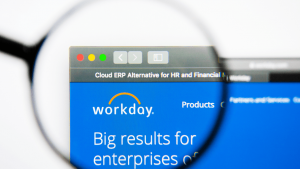- Erwann Couesbot
- Reading Time: 5 minutes

Over the past year, UpperEdge has seen Workday more frequently propose their Launch Deployment Program (Workday’s LDP) offering to customers. It appears Workday is attempting to penetrate the Midmarket with a bundled offering that promises faster implementation and value realization.
Like any system implementation provider, it is critical to properly assess whether that potential partner can be successful and whether their proposal is the best fit for your needs. Let’s take a look at the LDP offering and some of the key concerns.
What is Workday’s LDP Offering?
Launch Deployment Program or Lifecycle Deployment Plan (both names refer to the same LDP offering) is Workday’s implementation service targeting small to mid-sized businesses, typically up to 3,000 Full-Service Equivalent (FSE) workers. Workday markets its LDP offering to smaller customers, claiming that it benefits these businesses from seeking and investing in potentially expensive third-party implementation partners.
Our team received positive feedback from Workday customers who used Workday’s LDP. However, here are the top concerns to keep in mind when evaluating a Workday LDP proposal before making the jump:
Top Concerns for Customers Evaluating Workday’s LDP
1. Lack of Pricing Transparency
In many cases, Workday bundles the costs for both the software and implementation services in an LDP proposal, making it harder for customers to fully assess whether they are getting a good deal on either the solution or implementation side.
Typically, Workday will propose a fixed fee for the implementation without providing details around the time and materials estimate and the potential contingencies they may have applied to generate that fixed fee. In some cases, we have also seen Workday bundle the implementation and subscription costs and smooth out the cost of the 1 to 2 years deployment over the entire solution subscription term (e.g. 5- or 7-years).
For organizations evaluating Workday’s LDP without access to software pricing and implementation rates benchmarks, it can be difficult to properly evaluate whether your deal is competitive especially due to this lack of cost transparency.
2. Risk of Low Implementation Cost Estimates
Early in the process of evaluating and negotiating Workday’s LDP, Workday’s implementation estimates tend to be on the low end of the range. For example, we recently worked with a customer who went through a couple of rounds of scoping sessions and rate card negotiations with a third-party implementation provider. Based on a negotiated, highly competitive rate card, this third-party provider’s final consulting fee ended up being 3x what Workday initially estimated.
This does not mean that Workday’s estimate was inaccurate or indicative of Workday’s intention to lowball this customer. However, Workday’s estimate was missing a lot of details about the level of effort expected from each party and clarity associated with the assumptions of the project. This often means that Workday’s estimate assumes the customer will take on a lot of the work themselves.
When customers are under the impression that the LDP option is a simpler “plug and play” model, they also underestimate the effort that needs to go into a successful implementation, which can lead to unexpected and costly change orders down the line.
3. Lack of Effort Transparency
Workday often fails to identify the following critical effort estimates in their LDP proposals:
- Workday’s Level of Effort Breakdown: Workday typically does not specify the total estimated hours, nor do they break down these hours across different workstreams like functional, development, data, and OCM. Without this detailed breakdown, including identifying onshore/offshore resources, resource titles/seniority levels, and associated resource rates, customers are unable to validate if Workday’s proposal will meet their requirements and the associated risk profile.
- Customer’s Expected Level of Effort Breakdown: Workday will not provide an estimate of the customer’s level of effort for their activities unless specifically requested. For customers, clearly understanding their work scope and the associated level of effort is critical to being able to properly staff and meet these performance obligations.
- Key Decision Inventory: With any implementation, the number one risk is quality decision making. As the experts in implementing their solutions, Workday should provide customers with an inventory of key decisions that will need to be made by the customer throughout the program. This will enable customers to assign responsibility internally for who needs to be involved in making each one of these key decisions, identifying what information they need to make these decisions, and how much time they feel they need to contemplate and reach decisions. Not having this information up front leads to rushed and poor decisions, or to delays in making decisions, both of which lead to project risks and downstream change orders, with schedule and increased fees.
For small to mid-sized businesses, the decision to adopt Workday’s LDP necessitates a clear understanding of several critical factors. SMBs typically lack the experienced internal resources required for such projects, making transparency in Workday’s effort estimates crucial.
It’s important for these businesses to evaluate these efforts before committing to Workday’s software. Once signed, the subscription becomes non-terminable. This limitation also makes it impractical to switch implementation partners or seek alternative proposals through an RFP process while bearing the ongoing software costs.
4. Missing the Benefits of a Competitive SI Bid Process
Choosing Workday directly as your implementation partner without engaging in a competitive RFP process can result in missed opportunities. Here’s a detailed explanation of the most significant benefits of a competitive RFP bid process, instead of selecting Workday’s LDP along with the software solution:
- Enhanced Learning from SI Bidders: Participating in an RFP process allows organizations to gain insights from various SI contenders. This helps the customer understand different methodologies, technological capabilities, and service models, enriching your knowledge base and potentially uncovering innovative solutions that could be more suited to your specific needs.
- Opportunity to Compare Cost and Scope: By comparing proposals from multiple SIs, you can evaluate the market rates and services offered. This process enables you to identify the most cost-effective solution while ensuring that the scope of work aligns with your organizational requirements, helping to prevent overpaying for services or missing out on crucial features.
- Validation and Diverse Perspectives: Receiving similar proposals from different SIs can confirm that your planned approach is on the right track. Conversely, diverse proposals offer a range of perspectives, like getting a second opinion in a medical diagnosis, which can lead to a more comprehensive understanding of available options and innovative approaches.
- Negotiation Leverage: A competitive bidding environment can significantly enhance your negotiation power. With multiple offers on the table, you have the leverage to negotiate better terms, potentially leading to more favorable pricing, service level agreements, and contract conditions. This environment can also pressure vendors to offer their best services and terms right from the start.
Skipping this process when selecting Workday as your sole SI could lead to a lack of these critical advantages, potentially impacting the overall success and cost-effectiveness of your Workday implementation project.
The Bottom Line for Workday’s LDP
While Workday’s LDP offering presents an appealing, bundled solution for small to mid-sized businesses, there are significant factors and concerns to consider. These include the potential lack of pricing transparency, risks associated with low initial implementation cost estimates, and the need for greater clarity in effort estimates both from Workday and potential third-party partners.
Moreover, choosing Workday directly as your implementation partner might lead to missed opportunities inherent in a competitive RFP process. This blog has underscored the importance of thorough assessment and negotiation in adopting Workday’s LDP, highlighting the need for transparency, cost-effectiveness, and a strategic approach to ensure the successful integration of Workday’s solutions within an organization’s unique context.
At UpperEdge, we help customers properly evaluate and benchmark their program proposal to ensure you get the best deal possible. Explore our Workday Advisory Services to learn more about how we can help.
Related Blogs
Workday FSE Worker Counts: Why They Matter
Risk of Paying More for Workday is Greater Than You Think
Solved: How to Reduce Workday Pricing
About the Author
